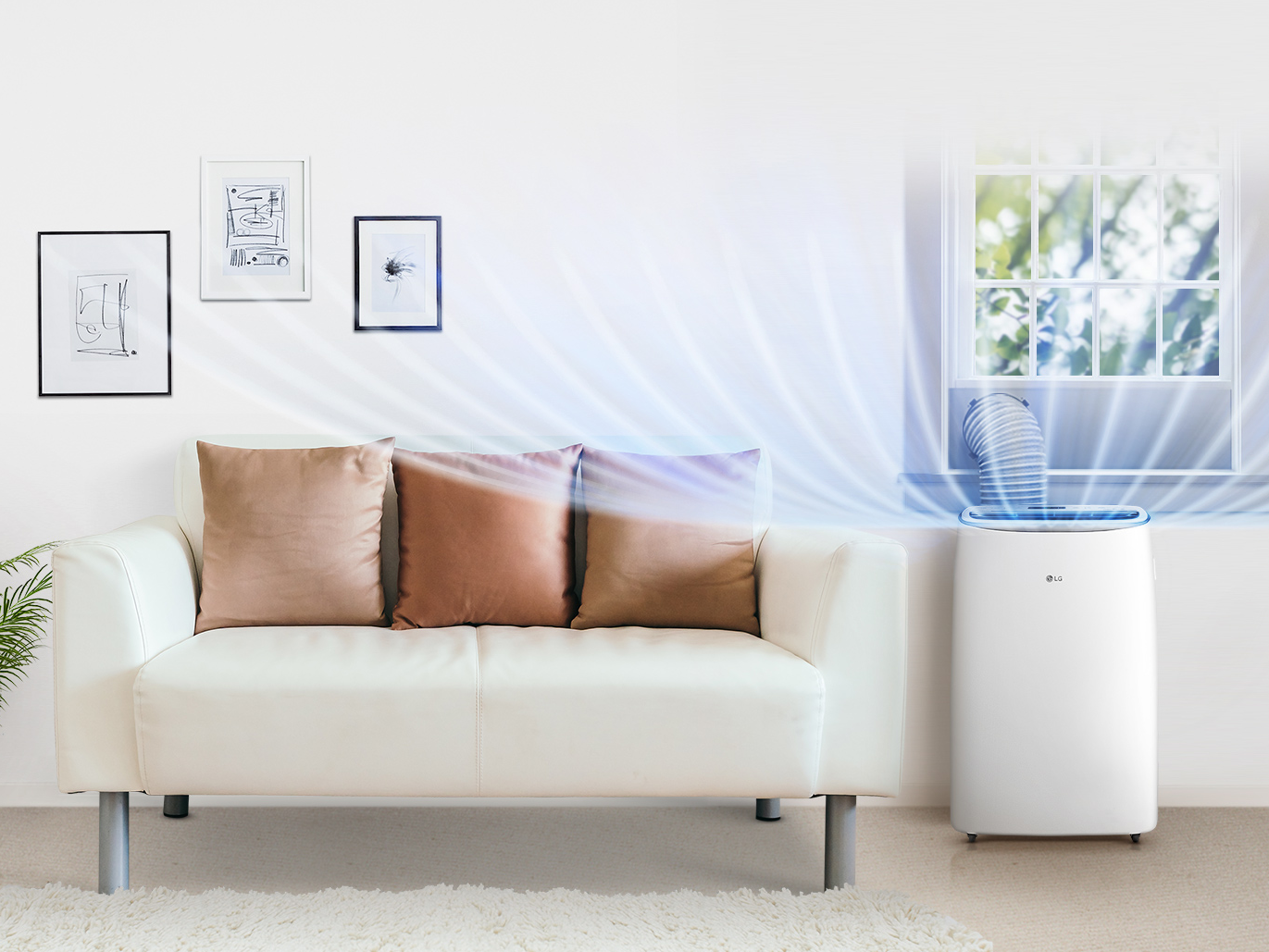- A high-quality portable air conditioner should cool a room efficiently, run quietly, and be easy to move from one room to the next.
- Our guide recommends ACs that performed well in our tests, have useful features that justify their price, and are designed to maintain a cool temperature in appropriately-sized rooms.
- The LG 14,000 BTU Smart Wi-Fi Portable Air Conditioner is our top pick because it has great performance, operates quietly, fits a broad range of room and window sizes, and has smart capabilities, including remote scheduling and voice control.
- Due to high demand, it’s currently out of stock and others are low in stock, but we’ll do our best to update when inventory becomes more available.
- Read more: The best window air conditioners
A portable air conditioner is a good solution for rooms that don’t have the single- or double-hung windows required for window units or those that aren’t frequently used, like a guest room. Portable ACs are more flexible with placement (you can roll them to where you need them), are easier to install, and can be used in places where window models aren’t allowed or feasible. Plus, they can be easily stored away when not needed.
However, convenience comes with a cost as these units tend to be more expensive. Also, since the entire device is located within the room it’s attempting to cool, portable ACs are less efficient than window ACs. In fact, portable models aren’t yet eligible for Energy Star certification, while window ACs are. Still, we looked for energy efficiency when shortlisting our recommendations.
What to look for in portable air conditioners
We talked to Matt Brown from the Home Comfort, Air Quality, and Floorcare division at The Home Depot, to learn more about what to look for in an air conditioner (The Home Depot was not involved in our testing and selection process). Brown said there were four primary factors to consider when shopping for an AC: room size, outlet type, window size, and extra features.
“ACs are rated by BTU (British Thermal Units) and range from 5,000 to 24,000 BTU, which correlates to 150-to-1500 square feet. The larger the BTU, the larger the room it covers,” Brown said. “It’s critical to not get a unit too big or small for a room for maximum cooling and efficiency.”
If you get a unit that is too big for a room, it will cool too quickly without removing the moisture, which will create a cold, clammy environment. An AC that is too small will be overworked, which boosts your energy costs.
Window size is also important. A portable AC still needs access to an opening for its exhaust hose in order to emit hot air. "Customers need to confirm the window opening is large enough to accommodate the unit," Brown said. "Each unit specifies how large the window needs to be to accommodate [it]."
When it comes to new technology, Brown said to look at inverter technology. "These units use more efficient motor technology that can ramp power up/down as needed while continuously running." Our top pick features a dual-inverter compressor.
Along with testing (read more about our testing methodology below, after our recommendations), we researched ratings and reviews of the top models from hundreds of experts and owners. All the units we recommend performed well in our tests, have useful features that justify their price, and are designed to maintain a cool temperature in appropriately-sized rooms. We also discuss a few honorable mentions that nearly made our list, which you may want to also consider.
The best portable air conditioners:
- Best portable air conditioner overall: LG 14,000 BTU Smart Wi-Fi Portable Air Conditioner (LP1419IVSM)
- Best budget portable air conditioner: Black+Decker Portable Air Conditioner (BPACT14HWT)
- Best portable air conditioner for medium-to-large rooms: Whynter 14,000 BTU Dual Hose Portable Air Conditioner (ARC-14SH)
- Best quiet portable air conditioner: Honeywell Portable Air Conditioner (HL12CESWB)
- Best mobile portable air conditioner: Whynter Elite 12,000 BTU Dual Hose Portable Air Conditioner (ARC-122DS)
Prices and links are accurate as of 7/27/2020. We updated this story with more technical information about BTUs.
The best portable AC overall
The LG 14,000 BTU Smart Wi-Fi Portable Air Conditioner is a well-rounded, energy-saving unit that can be controlled from a phone or Alexa.
What sets the LG 14,000 BTU Smart Wi-Fi Portable Air Conditioner (Model LP1419IVSM) apart from the other ACs we tested is its smart capabilities. It's supported by the LG ThinQ app, which allows you to use your phone as a remote controller, and you can set a schedule for when you want it to run. Additionally, it's Alexa-enabled, so you can control it with your voice.
The LG also has a dual-inverter compressor, which relies on variable motor speed to regulate temperature - rather than just being on or off. This makes it more energy-efficient than non-inverter ACs. LG estimates this saves up to 40% more energy.
It did not perform the best in our cooling tests, but it was within 0.4 degrees Fahrenheit of that category winner (Whynter ARC-14SH), a difference most people would not notice. It only took a little more than a minute to move from one room to the next thanks to its handles, smooth casters, and a dedicated slot for the window slider when in transport.
We also liked that the unit's noise level only registered 56 decibels on high and didn't exhibit any jolting sounds that might wake you up. Installation took a little longer than the other ACs we tested, but we liked that the window slider is big enough to accommodate windows up to 60-inches wide.
Wirecutter recommends the LG LP1419IVSM Portable Air Conditioner because it was more effective and quieter in its test than the other machines it tested. Despite using less energy than most ACs, the reviewer found this model delivered better cooling performance and dialed in a "more precise comfort level" than competitors. However, he notes that the unit is quite heavy, and though it has caster wheels and handles, it might be a pain to lug up and down stairs.
Pros: Can be controlled and scheduled using your phone, voice control, easy to move, performed well in cooling tests, fits a wide array of window sizes
Cons: Set-up took longer than most, one-year warranty
The best budget portable AC

The Black and Decker Portable Air Conditioner cools just as well as other units that cost hundreds of dollars more.
For its price, the Black and Decker Portable Air Conditioner (Model BPACT14HWT) does a lot. In addition to being one of the top performers in our cooling tests, this workhorse also has heating capabilities that come in handy during the colder months.
I purchased this AC for my bedroom and it's going on its third summer of use. It's one of the louder units we tested, but living on a major road that connects the main hospital to the freeway, I appreciate that the noise drowns out the ambulances. Yet, when I neglect to regularly clean the filter, the Black+Decker produces jarring sounds as it changes fan speeds. Fortunately, the filter is easy enough to clean.
Another negative is the poor EER of about 6.5. Its official Department of Energy BTU rating is 7,500, while it consumes a high amount of energy (1,160 watts).
Popular Mechanics recommends the Black and Decker BPACT14HWT for small rooms or to supplement central air systems that don't quite reach every corner of your house. The reviewer was impressed with the air distribution. Thanks to the louver design, the unit delivered cold air over a broad area.
Wirecutter also recommends this model as a "budget pick" because it did as good of a job cooling as the site's other picks, but is more affordable. Yet, the reviewer didn't like that the AC didn't have extras, was clunkier to control, and operated loudly.
Pros: Excellent cooling, fast set-up, five-year compressor warranty, heating mode
Cons: Loud operation, high-energy consumption
The best for medium-to-large rooms
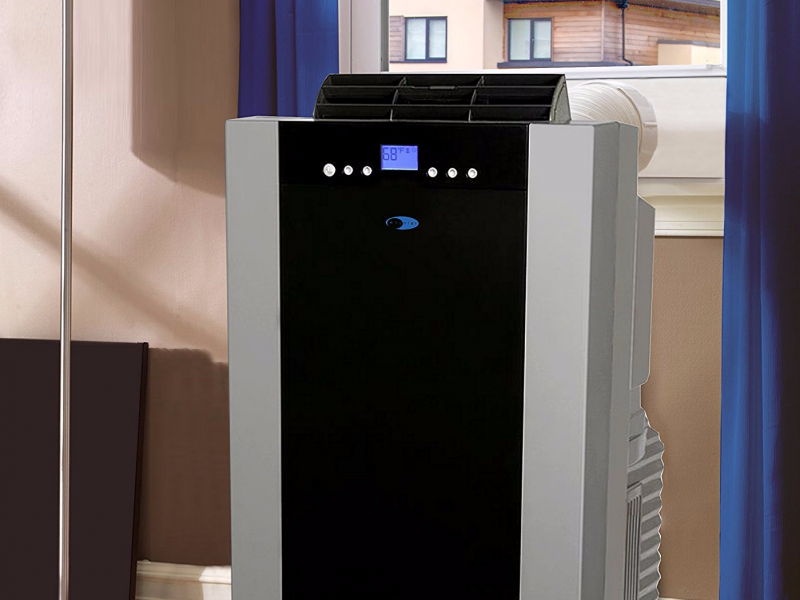
The Whynter 14,000 BTU Dual Hose Portable Air Conditioner may be big and not as portable, but it performed the best in our cooling tests, is relatively energy-efficient, and has a heater.
The first word that comes to mind when looking at the Whynter 14,000 BTU Dual Hose Portable Air Conditioner (Model ARC-14SH) is "monolithic." Weighing 86 pounds, it has an impressive Energy Efficient Ratio of 11.2, which means it does a good job of cooling without using an excessive amount of electricity. In addition to cooling, dehumidifying, and having a fan, the ARC-14SH also has heating capabilities.
In our tests, after two hours, the Whynter ARC-14SH Portable Air Conditioner lowered the room temperature more so than the other units we looked at. However, it was also the loudest model at 58 decibels, but the noise variance between all of the ACs we've tested is relatively small - the LG is 56 decibels and the Honeywell is 51.
The biggest negatives are that the unit is heavy and lacks handles, making it hard to move from room to room - not impossible but difficult (it took me 90 seconds). And, the initial installation took longer than most models because you need to screw the fixtures into the window slider. The slider was just short of being long enough for my 47-inch window opening.
Though Consumer Reports is unimpressed with portable air conditioners in general, it gave the Whynter ARC-14SH the highest score in its testing. The reviewer found it did a good job of quickly cooling a room, and based on owner surveys, it has excellent product reliability and good owner satisfaction. However, the misses include noisiness on low and high fan speeds and lack of venting.
While the standard warranty is one year for parts and labor, Whynter has an additional three-year warranty on the compressor. And, it comes with a storage cover for when it's not in use.
Pros: Top performer in our cooling tests, heating capabilities, comes with a storage cover, energy-efficient, three-year warranty on compressor
Cons: Cumbersome to move, longer set-up, loudest of our recommendations, window slider only fits windows up to 46-inches wide
The best quiet portable AC
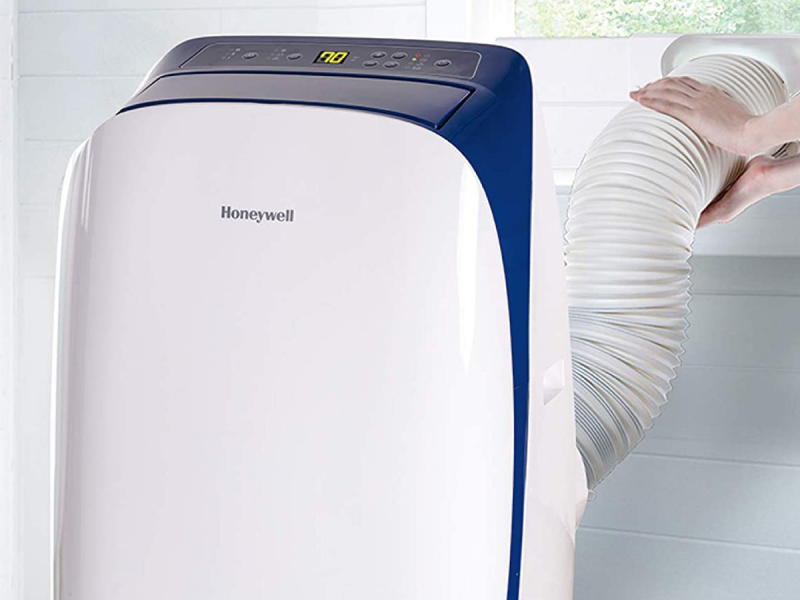
The Honeywell Portable Air Conditioner is the quietest unit we tested, plus its easy installation, mobility, and energy efficiency make it an excellent solution for small-to-medium rooms.
What sets the Honeywell Portable Air Conditioner (Model HL12CESWB) apart is its good, no-frills operation. The 12,000 BTU unit is really closer to 6,500 BTU per the Department of Energy's standards and is meant for rooms of 450 to 550 square feet. It has a sleek, relatively lightweight (67.3 pounds) design along with handles and casters that make it easy to move from room-to-room - a task that took me less than 80 seconds.
In our tests, the HL12CESWB was the quietest of all the air conditioners, at 51 decibels, on high. This makes it ideal for a bedroom or home office - or both, thanks to its portability. Taking only 10 minutes, set-up is easy, and the unit comes with adhesive and non-adhesive foam seals to ensure efficient cooling.
Among the units we tested, Honeywell was the poorest performer, coming in last. But that's not a deal breaker: All of the ACs performed similarly with only a difference of 1.2 degrees Fahrenheit in temperature change between the best and worst performers, after two hours.
Wirecutter recommends the Honeywell HL12CESWB because it has everything you need for quiet, efficient, and powerful air conditioning. However, the reviewer notes that there aren't really any major standout features. Popular Mechanics also recommends this model because it did an exceptional job of holding the target temp during tests. The reviewer also noted that it is "pleasant-sounding" and robustly-built.
Pros: Quick set-up, quiet operation, energy-efficient, easy to move, fits a broad array of windows, excellent installation kit
Cons: Average cooling abilities, minimal warranty (one year)
The best for moving around

With its handles and smooth-rolling casters, the Whynter Elite 12,000 BTU Dual Hose Portable Air Conditioner is easy to move from one room to the next on the same floor.
All portable air conditioners are designed to be moved around, hence the word "portable." That's true with all of our picks, but that's not something you want to do often: they are heavy and require some sort of installation. If you need a portable AC that's highly mobile, check out the Whynter Elite 12,000 BTU Dual Hose Portable Air Conditioner (Model ARC-122DS). It has a powerful 12,000 BTU output, while only consuming 1,080 watts of power, giving it an excellent EER of 11.1. Like most other portable ACs, this model has fan and dehumidifying modes. Plus, it comes with a remote control and covers for the window slider holes for when you're not using the unit.
In my portability tests, the ARC-122DS had the fastest times - taking only 72 seconds to uninstall in one room and reinstall in another. This is an excellent solution if you want to move your AC, provided the rooms are on the same floor. The caveat: At 76 pounds, it is heavy, which means you might need some help moving from floor to floor.
The cooling power of the ARC-122DS was in the middle of the pack in our tests. Yet, it was one of the quietest, registering just 55 decibels while on high power.
On the downside, the ARC-122DS took the longest for us to set up, at 35 minutes. It requires a screwdriver to attach the fixtures to the window slider. And, the window slider only fits windows up to 46-inches long; our test window is about 47 inches.
Pros: Easy to move from room to room, energy-efficient, quiet operation, three-year warranty on compressor, comes with storage cover and remote control
Cons: Longer set-up process, average cooling performance, may not fit wider windows
What else we've tested and researched
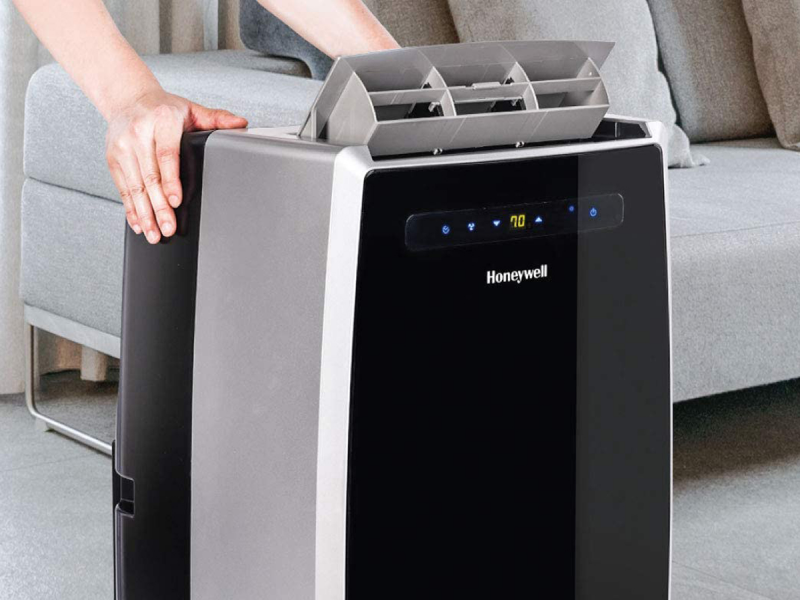
We tested and researched many portable air conditioner models and brands while researching this guide. The following five ACs barely missed the cut but are worth looking into:
Honeywell MN10CES ($367.99): There's a lot to like about this Honeywell model, including its affordable price tag and outstanding performance in our cooling tests. We also liked that it's easy to set-up and can fit a wide variety of window sizes. But, it's relatively loud and makes jarring sounds as it switches between fan speeds, which could wake you up. It also had the worst EER of the units we tested.
LG LP0817WSR ($329): This model was previously in our guide and might still be a good option if you need an affordable AC for a small space (about 200 square feet.) Plus, its small size and handles make it easy to move from room to room. But it does not provide enough cool air for most uses, the one-year warranty is stingy, and there are many consumer complaints of shipment issues.
Frigidaire FFPA1222U1 ($469): Frigidaire's standard portable air conditioner comes with a useful window installation kit complete with foam seals for better insulation and a drain hose to continuously remove condensation. It also fits a range of window sizes and is backed by a limited five-year warranty on the compressor and other parts of the sealed system. Yet, the low EER and variety of unsettling sounds it emits make it a runner-up in our guide.
Frigidaire FGPC1244T1 ($608.87): Frigidaire's smart AC was previously on our list because of its many high-tech amenities, including compatibility with smart home systems and Alexa voice controls. We also gave it high marks because of its built-in air purifier and stylish design. We downgraded it because of the low EER and high energy costs. Plus, for its price, it doesn't cool much space - up to 550 square feet.
Friedrich Zoneaire Compact Portable 8,000 BTU ($399): The Zoneaire AC is super-portable thanks to its compact design and hose storage compartment under the device. Plus, it has heating and dehumidifying capabilities. We chose not to include it based on poor performance in expert testing. For instance, Consumer Reports found it took a long time to cool a large room, and no matter what cooling power it was on, it operated loudly.
How many BTUs do you need to cool your room?
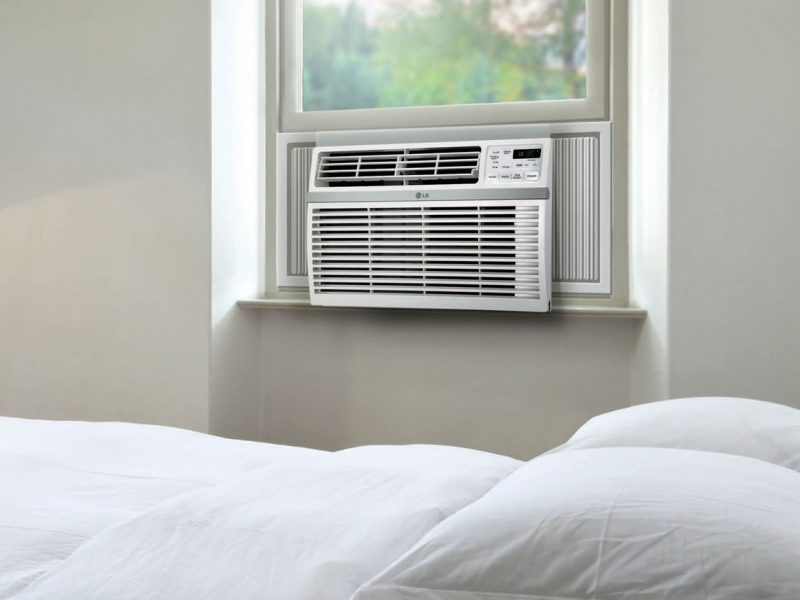
When you're shopping for portable AC units, it's best to prioritize the size of the area you wish to cool, rather than the size of the actual unit. To pick the most appropriate model, you'll want to match the British Thermal Unit (BTU) requirements to the room size you plan to use it in.
BTU is the international measure of energy, and a BTU is the amount of heat needed to raise one pound of water by 1 degree Fahrenheit at sea level. When it comes to air conditioners, manufacturers use BTUs to indicate the quantity of heat a conditioning unit can remove from a room per hour. One BTU per hour is equal to 0293 watts.
As the BTU rating increases so do the weight, size, and cost of the air conditioner, but you have to make sure you get the right cooling capacity for your space. If you purchase a unit that has a higher BTU rating than the room requires, it will cycle off too quickly and won't remove the humidity from the air properly. On the other hand, if you purchase a portable air conditioner that has a lower BTU rating than the room requires, it will run continuously and never cool the room adequately.
Check out the breakdown below:
- A 150 sq. ft. room requires 5,000 BTUs
- A 250 sq. ft. room requires 6,000 BTUs
- A 350 sq. ft. room requires 8,000 BTUs
- A 450 sq. ft. room requires 10,000 BTUs
- A 550 sq. ft. room requires 12,000 BTUs
- A 700 sq. ft room requires 14,000 BTUs
How we test portable air conditioners
There are many tests I put each model through, and I extrapolated the key performance indicators based on the testing results from other trustworthy sites like Popular Mechanics and Consumer Reports. Here are the main attributes we look for and how we test them:
Cooling: I set the unit up in a 550-square-foot room and cranked the AC on its highest setting with the goal of achieving the lowest temperature possible. I then used a digital thermometer placed at the opposite end of the room from the AC to compare the starting temp (about 78 degrees Fahrenheit) to the temp two hours later.
Portability: To test this, I used a stopwatch to time how long it took me to uninstall the unit, move it to the next room, and reinstall it. There was a three-quarter-inch lip in the flooring between the rooms, so handles were important. And, the weight of the unit was taken into consideration.
Extras: All of the models I tested came with remote controls and had dehumidifying and fan modes. This was the baseline. To score well in the extras department, the AC had to have more than the basics, this could include anything from cord storage and a drain hose to more important features, like heating and Wi-Fi capabilities.
Noise: Whether you're sleeping, working, or watching a movie, you don't want your room's air conditioner to be loud and distracting. To test this, I cranked the AC to its highest setting and used a sound meter to measure the decibels from 6-feet away. I also paid close attention to what sounds the device made as it switched between fan speeds. If the change was jarring, the model lost points.
Set up: To assess set up, I timed how long it took me to unbox and install the air conditioners. I also noted whether you needed tools to complete the job. None of the models took more than 35 minutes to install, and I didn't need anything more than a Philips screwdriver to do it.
Additionally, we looked at how many BTUs each model is rated for (the energy measurement for air conditioners), recommended square footage (for more info), what window sizes it fits, energy-efficiency ratio (EER - BTUs divided by Watts), and warranty information.
When shopping for air conditioners, slight differences in model numbers are acceptable. Model numbers may vary by a number or letter due to differences in BTU ratings or colors. It's more important that you get the right BTU for your room.
Check out our other related stories

The best window air conditioners
A good air conditioner can help make those hot summers much more bearable. These are the best window air conditioners you can buy.
The best electric fans you can buy
When you're trying to beat the summer heat outdoors, a glass of lemonade at the pool works great, but beating the heat indoors works best with an electric fan. Here are our picks for the best electric fans you can buy.
